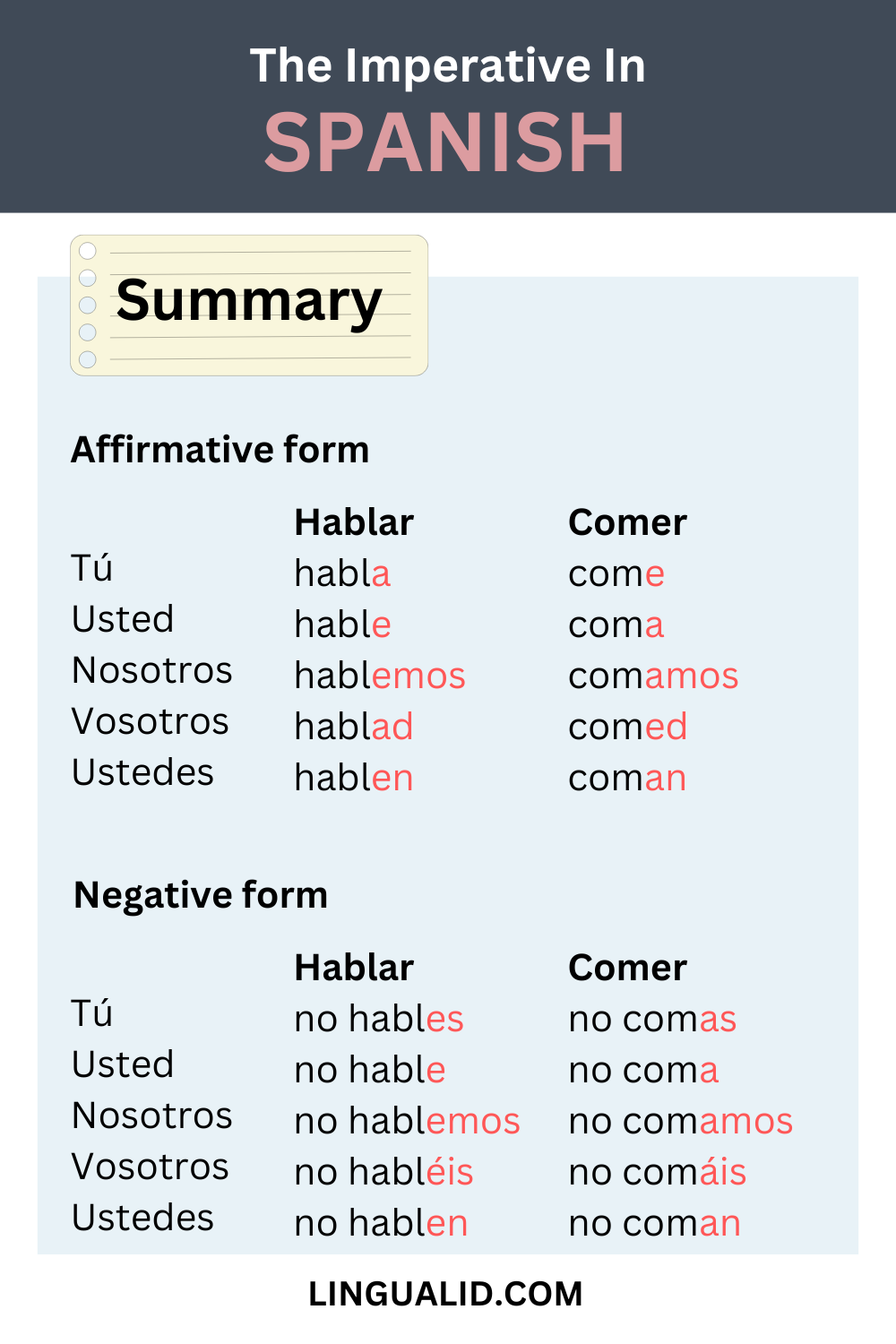In this lesson, we will talk about the imperative in Spanish, and how to use it to give command on both affirmative and negative forms.

The imperative (also known as command) is the tense used when we want to give an order, or recommend or give instructions, and in Spanish, for the regular verbs, it’s formed easily by replacing the endings “ar, er, ir” with the appropriate ending, look at the following tables:
Verbs ending with -AR
| Pronoun | imperative ending |
| Tú | -a |
| Usted | -e |
| Nosotros | -emos |
| Vosotros | -ad |
| Ustedes | -en |
Example: Estudiar (to study):
| Pronoun | imperative |
| Tú | estudia |
| Usted | estudie |
| Nosotros | estudiemos |
| Vosotros | estudiad |
| Ustedes | estudien |
Example: Hablar (to speak)
| Pronoun | imperative |
| Tú | habla |
| Usted | hable |
| Nosotros | hablemos |
| Vosotros | hablad |
| Ustedes | hablen |
Note: you can practice what you’ve learned here, and learn how to pronounce each of the words in our Memrise course here, don’t know how to use the platform or sign up? we’ve got you covered in this easy-to-follow tutorial here.
Verbs ending with -ER and -IR
| Pronoun | imperative ending |
| Tú | -e |
| Usted | -a |
| Nosotros | -amos |
| Vosotros | -ed |
| Ustedes | -an |
Example: aprender (to learn)
| Pronoun | imperative |
| Tú | aprende |
| Usted | aprenda |
| Nosotros | aprendamos |
| Vosotros | aprended |
| Ustedes | aprendan |
Example: comer (to eat)
| Pronoun | imperative |
| Tú | come |
| Usted | coma |
| Nosotros | comamos |
| Vosotros | comed |
| Ustedes | coman |
Example: decidir (to decide)
| Pronoun | imperative |
| Tú | decide |
| Usted | decida |
| Nosotros | decidamos |
| Vosotros | decided |
| Ustedes | decidan |
Example: recibir (to receive)
| Pronoun | imperative |
| Tú | recibe |
| Usted | reciba |
| Nosotros | recibamos |
| Vosotros | recibed |
| Ustedes | reciban |

The Negative Form Of The Imperative
To use the imperative in its negative form, put the word “No” in front of the verb and then add the appropriate ending:
Verbs ending with AR
| Pronoun | imperative ending |
| Tú | -es |
| Usted | -e |
| Nosotros | -emos |
| Vosotros | -éis |
| Ustedes | -en |
Example: Hablar (to speak)
| Pronoun | imperative (negative) |
| Tú | no hables |
| Usted | no hable |
| Nosotros | no hablemos |
| Vosotros | no habléis |
| Ustedes | no hablen |
Verbs ending with -ER and -IR
| Pronoun | imperative ending |
| Tú | -as |
| Usted | -a |
| Nosotros | -amos |
| Vosotros | -áis |
| Ustedes | -an |
Example: comer (to eat)
| Pronoun | imperative ending |
| Tú | no comas |
| Usted | no coma |
| Nosotros | no comamos |
| Vosotros | no comáis |
| Ustedes | no coman |
Spanish Imperative Tense Review
Questions:
- What is the Spanish imperative tense used for?
- How do you form the imperative tense for regular verbs ending in “-AR”? Provide an example.
- How do you form the imperative tense for regular verbs ending in “-ER” and “-IR”? Provide an example.
- What is the difference in the imperative endings for “Tú” and “Usted” for verbs ending in “-AR”? Illustrate with an example.
- What is the difference in the imperative endings for “Tú” and “Usted” for verbs ending in “-ER” and “-IR”? Illustrate with an example.
- How do you form the negative imperative in Spanish?
- What is the negative imperative ending for “Tú” for verbs ending in “-AR”? Provide an example using the verb “hablar”.
- What is the negative imperative ending for “Vosotros” for verbs ending in “-ER/-IR”? Provide an example using the verb “comer”.
- Besides giving commands, what are other uses of the imperative tense in Spanish?
Answer Key:
- The Spanish imperative tense is used to give commands, orders, recommendations, or instructions.
- To form the imperative for “-AR” verbs, replace the “-ar” ending with the appropriate ending for the subject pronoun. For example, “Hablar” (to speak) becomes “Habla” (You – informal singular – speak).
- To form the imperative for “-ER/-IR” verbs, replace the “-er/-ir” ending with the appropriate ending for the subject pronoun. For example, “Comer” (to eat) becomes “Come” (You – informal singular – eat).
- For “-AR” verbs in the imperative, “Tú” uses the ending “-a” (e.g., “estudia”), while “Usted” uses “-e” (e.g., “estudie”).
- For “-ER” and “-IR” verbs in the imperative, “Tú” uses the ending “-e” (e.g., “come”), while “Usted” uses “-a” (e.g., “coma”).
- To form the negative imperative, place “No” before the verb conjugated in the imperative tense.
- The negative imperative ending for “Tú” with “-AR” verbs is “-es”. For “hablar” (to speak), it is “no hables” (don’t speak).
- The negative imperative ending for “Vosotros” with “-ER/-IR” verbs is “-áis”. For “comer” (to eat), it is “no comáis” (don’t eat – you plural informal).
- Besides commands, the Spanish imperative is also used to give advice, make requests, and offer suggestions.
Glossary of Key Terms:
- Imperative Mood: A grammatical mood used to express direct commands, requests, or prohibitions.
- Affirmative Imperative: The form of the imperative used to give a direct command or instruction.
- Negative Imperative: The form of the imperative used to give a negative command or prohibition.
Happy learning!
Oualid Cheddadi is the founder of Lingualid, a platform that inspires independent language learners worldwide, regardless of the language they are learning. The name “Lingualid” is derived from the Portuguese word for “language,” “língua,” and the last three letters of Oualid’s name, “Lid.”



